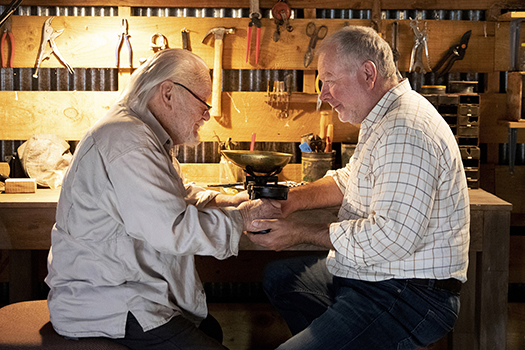
I’ve been thinking a lot about actors. Many screenwriting books explore structure & plots & saving cats, but not many address the active/acting elements of a script. Actors read a script in a particular way. They’re looking for specific opportunities. And the more you give them, the better they like your work.
1. Live by the Nichols & May Principle
When Mike Nichols and Elaine May were creating their stage act, they went through a long learning process. Eventually, they settled on a formula:
“The greatest rule was [Elaine May’s]: ‘When in doubt, seduce.’ That became the rule for the whole group. And looking back, because I did teach acting for a while, we figured out over a long time that there only were three kinds of scenes in the world—fights, seductions, and negotiations.”
Mike Nichols (Who’s Afraid of Nichols & May, Vanity Fair 2013)
It’s a useful rule of thumb to keep in mind as a screenwriter. If you write a fight, a seduction, or a negotiation, it means that actors are always striving for something. They have agency:
The Birdcage was written by May and directed by Nichols. It’s a blizzard of fights, seductions, and negotiations, with Nathan Lane’s character standing in the middle of the storm.
Once you know about this principle, the possibilities are endless. You can create loving fights, cold-blooded seductions, or even playground negotiations between 5-year-olds. Just keep in mind what the actor wants to achieve. Which leads us to…
2. Place Obstacles in Front of Wants
In their first acting class, actors are taught to think about what their character wants in a) the scene; and b) the larger story. For example, as a character, I might want to:
- Persuade my mother to let me go on tour with a rock band so I can become a famous writer. (Almost Famous)
- Reclaim my father’s body so I can save my rural family’s reputation. (Vaya)
- Teach a stubborn deaf & blind child how to sign one word so she can explore the joys of the world. (The Miracle Worker)
But as Jack Lemmon points out, actors actually thrive on obstacles to these wants. An obstacle is a closed bathroom door when you’re trying to propose. Or your boss demanding the key to your apartment when you want to recuperate from a cold. Or:
Plots are built on obstacles: “I can’t do it this way, so I’m going to have to rethink my strategy and do it this way.” If you can come up with unusual and creative challenges for your actors, then you’ll make them very happy.
3. Challenge Actors to Pass the Power Stick
In the world of fights, negotiations & seductions, characters are constantly vying for the Power Stick. This is an invisible baton that one actor can hold at any time in the scene. Think of the Godfather. It’s rare that he lets it go.
The Power Stick can be taken by force or by stealth. It can be handed over in defeat to another character or willingly passed along. But it’s fascinating for an audience to watch it being transferred:
When you’re putting together a scene, establish in your head who holds the Power Stick at the beginning and the end. Build in moments when the stick can be tussled over & transferred. This will help the actors create tension. Speaking of tension…
4. Create Moments of Counterpoint
Counterpoint is a key element in a good film. The best movies will lace a comedy with tragic notes and lighten a tragedy with comic interludes. Great actors love to work with these moments because they show how absurd life can be.
Shakespeare was a maestro of counterpoint—it’s present in every one of his plays. Observe how Ben Kingsley, Imelda Staunton, and Mel Smith play with the possibilities in the “comedy” of Twelfth Night:
And Awkwafina and her family collaborating to trick her grandmother.
Moments of counterpoint have an added benefit—they keep an audience on their toes. Like a punchline to a joke, these touches in scenes are both unexpected and strangely satisfying.
5. Allow for Bits of Business
Actors often get stuck in cars, in elevators, in offices—in deadly dull environments where there’s a solid chunk of dialogue and not much else to do.
Sometimes a lot of dialogue is necessary. In a hyper-verbal comedy like When Harry Met Sally, the film is built on conversation. But have a look at what’s used to punctuate this scene:
Harry’s “bit of business” is eating the grapes. But the way that he eats them—and Sally’s reactions—tell you so much about their characters.
It’s a delicate business (pardon the pun). If you throw in bits that aren’t organic to the character, it looks like pandering. If you add too many bits, the audience gets weary of actors trying to steal scenes. But a judicious bit here and there can turn a pedestrian scene into an illuminating one.
6. Give Scenes the Lubitsch Touch
Born in Berlin, Ernst Lubitsch came to Hollywood in the 1920s and established a name for himself as a director of unparalleled wit & sophistication. Hal Wallis said his work had “The Lubitsch Touch.” Here’s how Billy Wilder describes the dramatic approach:
And here’s the scene in question:
Once you have the idea, you can apply the Lubitsch Touch to scenes of drama & tragedy—you’re simply substituting the most effective actions & behaviors for over-explanatory dialogue. It’s beautiful filmmaking. And actors will adore you.
7. Let Actors “Dance” Together
In cinema, the camera moves. The actor moves. Or they both move. The choices are endless. But it’s always nice to give actors a reason to move with each other.
I call it dancing. Even though directors are in charge of the blocking, screenwriters can build opportunities for motivated movements into the script. Here are some examples of how actors can “dance” together to serve the story:
The Drama of Men in Rooms
The Comedy of Men in Rooms
The Choreography of Chaos (Content Warning)
8. Structure Your Monologues
Ron Shelton, writer/director of Bull Durham, once said that he wrote the famous “I Believe” monologue in order to land a movie star for the film. It worked. Actors love monologues—it’s where they win their awards and their biggest fans.
But watch Mark Rylance pick apart this Bridge of Spies speech from writers Matt Charman and the Coen Brothers:
Notice how it’s structured. There’s the exposition—the mysterious man who comes to visit. The complication—the arrival of the Partisan Border Guards. And the resolution with a twist—he would not surrender. This man standing in front of him.
Notice, too, how Rylance varies his vocal rhythms, uses the gesture of the cigarette, adds a bit of laughter, and rolls his tongue on his teeth. He’s highlighting the structure.
Sondheim always said that a song in a musical should intensify the moment or move the plot forward. Monologues serve the same function in a film.
